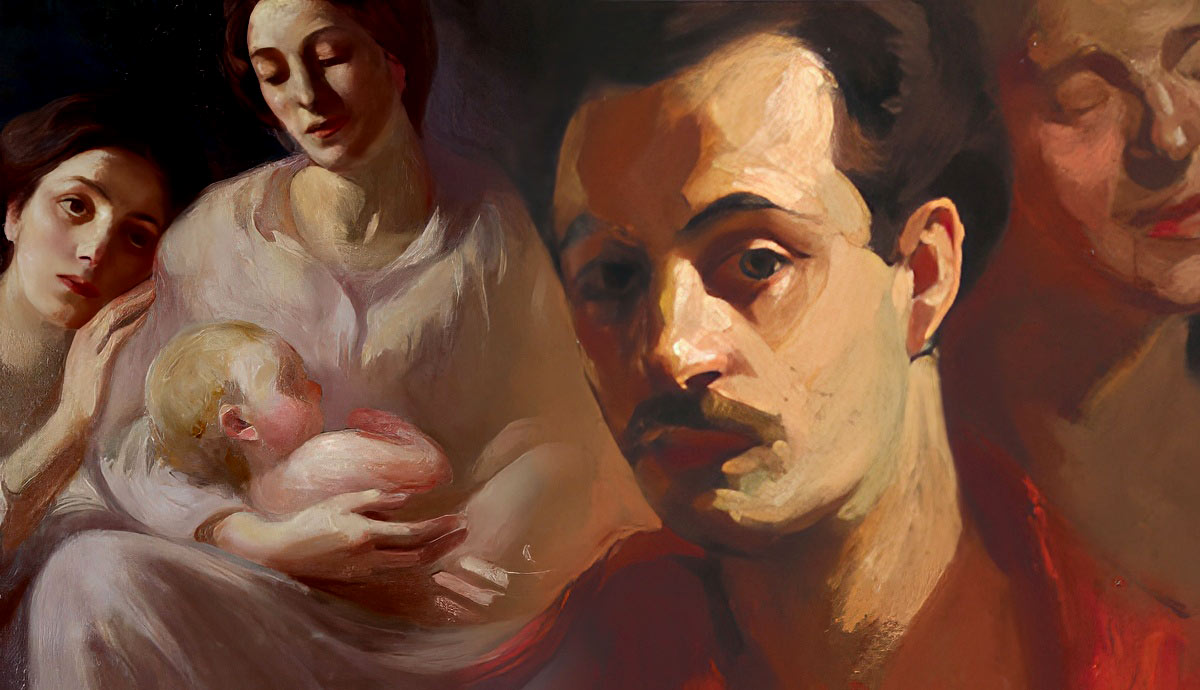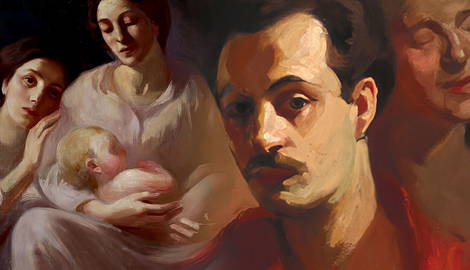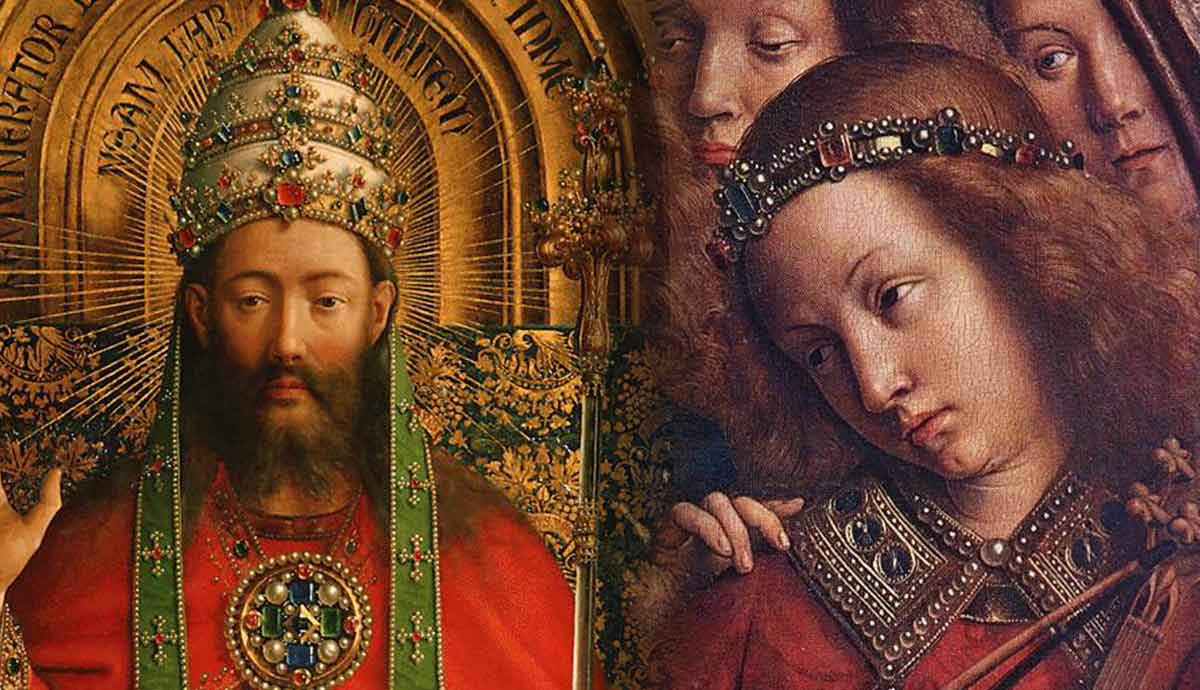
summary
- Kahlil Gibran: A Lebanese-American writer well-known for his literary works, he also produced a large collection of mystical visual art.
- Interconnected Influences: The themes explored in his written works and artworks are interconnected, exploring universal truths and mystical themes.
- The Human Body: Much of Gibran’s artwork focused on the human body, using it as a vehicle for philosophical and allegorical concepts. He produced many portraits of his inner circle.
- Classical Expression: One of the reasons Gibran’s art is often overlooked is that he adhered to the classical style, when Expressionism and artistic exploration were on the rise
Kahlil Gibran (1883-1931) is one of the most widely read and translated writers of the 20th century. His visual art work was an inextricable part of his life and literary career, but is often overlooked. Described as mystical and ethereal, Gibran’s artworks give form to the universal ideas and fundamental truths deeply embedded in his parables and poems. In other words, his writing informs his drawing as much as his drawings illustrate his texts. Discover the life of Gibran through his artworks.
Early Inspirations and a Longing for Home

Kahlil Gibran was born in Bcharre, in modern-day Lebanon, in 1883. Gibran was a curious and imaginative child. One of his earliest influences was Leonardo da Vinci. In 1895, Gibran immigrated to Boston with his family. He became part of Boston’s thriving cultural scene, primarily due to the influence of Fred Holland Day (1864-1933), a photographer and teacher. He trained Gibran in academic drawing, focusing on anatomical correctness and portraiture.
From 1908 to 1910, Gibran traveled to Paris to study at the Académie Julian. He bonded closely with fellow countryman and sculptor Youssef Howayek (1883-1962), who later became a key figure in Lebanese modernism. The two would pour over the works of Renaissance masters, studying the Classical humanist forms and depictions of the body. Other influences included William Blake (1757-1827), who Gibran later referred to as the god-man, French Symbolists Odilon Redon (1840-1916), Pierre Puvis de Chavannes (1824-1898), and Eugène Carrière (1849-1906). These early influences remained prominent threads throughout Gibran’s life. Combining classical forms with mysticism and Symbolism was at the root of his unique and fascinating visual style.

Geography, both real and imagined, played a role in Gibran’s creative pursuits, both literary and visual. Gibran never lost his attachment to his homeland. Despite leaving Bcharre for Boston at a young age, he never lost his connection to the sensations he associated with the Mediterranean. Historians often write about his position between the East and the West, between nostalgia and reverence for his homeland, and his relationship with his later homes in Boston, Paris, and New York.
Authenticity In Times of Change

One reason Gibran’s artworks might not have received the same attention as his written work is their adherence to classical forms in a time of artistic foment. He continued reproducing humanist forms, albeit with an unusual mystical quality, while artists around him experimented with new visual languages. His depictions of the human body and portraiture aligned with his vision of the world but would also be considered aesthetically kitsch.
He was a Symbolist in an age of Cubism and Surrealism. His work would be more at home in a book on 19th-century art than in one about the art of the 20th century. He was not resistant to new styles, but did not feel that they could capture his emotional approach to the world the way Symbolism and Classicism could. In this way, he was not avant-garde so much as timelessly authentic.
Representing Higher Ideals and the Body

Gibran had been writing and publishing in Arabic since 1905, but in 1918, he published his first book in English, called The Madman, which he illustrated himself, most famously with The Three Are One, which acted as the frontispiece for the book. It depicts three figures, with the exact relationship between the three is left open to interpretation. It is often interpreted as a visual representation of his philosophical ideas about the interconnectedness of life, rebellion, and truth, or love, rebellion, and liberty.
Gibran was drawn to portraying the human body throughout his life. The body was often a vehicle for allegorical or symbolic concepts. Rather than engaging in narrative compositions, his figures reflect philosophical ideas of nature and the relationship between man and God. Alice Raphael compiled these figurative allegorical works in the first book dedicated to Gibran’s artworks, titled Twenty Drawings, published in 1919. At this time, Gibran worked mostly with light mediums like watercolor, charcoal, and graphite.
This compilation offers insight into Gibran’s spiritual vision, which he communicated through light and diffused colors that wrap around supple, curvilinear bodies. It is here that we understand best how beauty was, in the words of scholar Francesco Medici, “the arbiter and the essence of Gibran’s art, an art that becomes a mystical-aesthetic experience, a pathway to the original and absolute, ineffable and eschatological truths of man.”

The Greater Self from 1916 exemplifies the compositions reproduced in this volume. Figures representing allegorical and symbolic concepts are rendered in non-spaces, and their features are concealed. They are genderless and exist outside of time in a liminal space where only the conceptual can thrive. Of these works, Raphael said:
“Kahlil Gibran is one of the artists who are engaged in the struggle between the old and new or, as in other times the conflict was termed, the oscillation between the classic and the romantic tendencies in art. Gibran is also caught in the struggle which is the besetting problem of the world today, the reconstruction of an era which will adjust the imperishable legacy of the ancient world, the classic traditions, with the ever evolving, fluctuating tendencies in art which constitute the essence of true Romanticism.”
Mythological Paintings and Endearing Portraits

At the turn of the century, Gibran found himself in Paris. He began experimenting with oil paint to create some of his most sensual and successful works. Autumn from 1909 was featured in the Salon de Printemps at the Société Nationale de Beaux-Arts in Paris. This piece represented a departure from the soft, ethereal nature of earlier artworks. In this work, Gibran paints a nude bust of a woman with hair the color of autumnal leaves. She leans back as if resting, her left arm folded over her head.
During this time, Gibran found a deeper appreciation for color and its spiritual nature. Another oil painting from 1911, entitled Rose Sleeves, features a similarly rich palette and depicts the mythological poet Sappho, the female counterpart to Orpheus, who possessed godly musical abilities.
Gibran also depicted friends, colleagues, and family members who sat for him. He was apt at translating the soul and personality of his subjects into visual language. One of his longest projects was a collection of portraits of influential cultural figures including Claude Debussy (1862-1918), Auguste Rodin (1840-1917), Edmond Rostand (1868-1918), Thomas Edison (1847-1931), philosopher Carl Gustav Jung (1875-1961), and actress Sarah Bernhardt (1844-1923). He also depicted close friends such as Ameen Rihani (1876-1940), author of The Book of Khalid. Part historical document, part visual diary, these portraits attest to Gibran’s attention to the human psyche and the divine within men.
Searching For the Divine Feminine and Universal Mother

Gibran’s close relationships were not numerous, but they were deep, some extending the course of his life. Mary Haskell (1869-1953) was perhaps the most significant person in Gibran’s life. Introduced at Gibran’s second exhibition in Boston by Holland Day, Haskell and Gibran became fast friends and lovers for a short time. Gibran drew and painted many portraits of Haskell during his time, each reflecting his profoundly emotional understanding of her personality and soul. He was devoted to her, and she remained a confidante, partner, and financial backer for Gibran throughout his career. It was Haskell who revised Gibran’s unfinished manuscript of The Garden of the Prophet for posthumous publication in 1933.
Depictions of Haskell are serene and lovingly composed. Her face relaxed with a soft smile. She was the light counterbalancing Gibran’s internal darkness. Other women in Gibran’s life would enter his oeuvre, including Charlotte Teller (1876-1953) and Emilie Michel, who was called Micheline by Gibran. While Michel appears in stark compositions, Teller was the subject of more complex portraiture. Her signature hair and long neck are easily recognizable.

The idea of family was meaningful to Gibran, although severe losses marked his life. Gibran was close to his sister Marianna, who survived the illness that took the lives of his two other siblings and his mother during their first years in Boston. Gibran’s depictions of Marianna are tender and intimate, demonstrating their close bond. The other woman who dominated Gibran’s psyche was his mother. Despite her untimely death, Kamileh Gibran was an influential figure for young Kahlil. He depicted her several times posthumously. Scholars attribute Gibran’s attachment to his mother to a larger reverence for the Universal Mother or Mother Earth, parallel to his belief in reincarnation. According to Joseph A. Fenianos, President of the Gibran National Committee, Gibran longed to “live in peace, in a united family where the mother is the world itself and life protector.”
Kahlil Gibran’s Timeless Body of Work

Gibran’s literary and artistic pursuits were not siloes, existing in isolation. The two disciplines overlapped, often with extraordinary results. He illustrated many of his written works, including the first edition of The Prophet, his most famous work, published in 1923. Two of the twelve illustrations reproduced to accompany the original text were done in black and white, while the others were made using an array of soft watercolors in bright colors. Many drawings have similar mountainous elements in the landscapes surrounding the figures.
Alexander Najjar, author of the comprehensive archival and biographical tome Gibran, attributes this to Gibran’s lifelong attachment to Bcharre and the connections he often made between spiritual concepts and the mysticism he attributed to his homeland. His ability to represent universal concepts, expanding beyond temporal or physical limits, allowed him to continually return to Lebanon in his mind and render it in his artworks. It is also what makes his body of work timeless.










